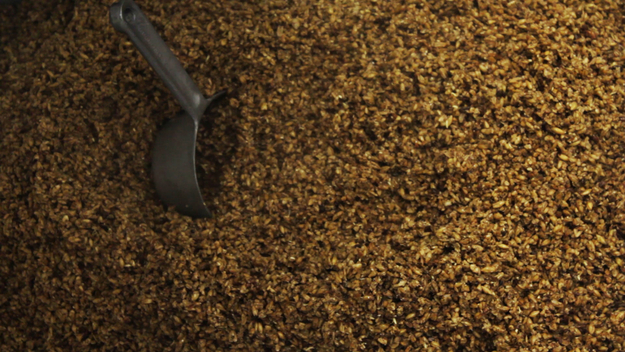The project
Here at Mediamatic we don't see waste as a throw away material but instead as an opportunity for innovation. We have a vision to combine a surplus material with the biology of mycelium into a product.
We are using the spent beer grain from our myco brewery as a substrate to grow insulation panels with mycelium. The mycelium, more commonly known as the roots of mushrooms, acts as a binding agent for the grains which together will form a solid material that has many similar properties as insulation for buildings. It is very light weight, fire retardant, and water resistant and we hope it will also keep our black barn warm during the winter.
Brewing
The grains finish their job in the brewing process about halfway through, having released most of their sugars into the malt beer. At this point you are left with grains that are still quite rich in nutrients, although less rich in sugars than fresh grains. The low sugar content is essential, as this makes the grains less vulnerable to contamination.
Centrifuge
The grains are still very wet at this point, which does not make for a suitable substrate to grow mycelium on. Therefore, the grains are dried using a centrifuge, leaving a slightly moist, but not dripping substrate.
Weighing and Bagging
The following day, all the grain is transferred into grow bags. These are plastic bags with an air filter that will make sure no contaminants can come in while still providing the mycelium with oxygen. Each bag is filled with 1200g of grain and then sealed.
Sterilization
The grains are, at this point, still full of countless micro-organisms that would all form threats to the vulnerable mycelium when it is trying to colonize the grain. To eliminate all these competitors, we sterilize the bags of grain in a pressure cooker at 121ºC for 3 hours.
Cooling
After sterilization, the bags are taken out of the pressure cooker and left to cool down overnight before the spawn (mycelium starter) is added. This is important because if the grains are still hot the mycelium would be killed immediately. The grains need to be around 26ºC.
Inoculation
Now we can inoculate the bags with spawn. Spawn is a starter of mycelium, existing out of well-colonised grains of some sort, often rye or millet. The inoculation is nothing more then adding the spawn to the beer grain. The grow bags are opened, exposing the grain to air and therefore contaminants. To reduce the risk of contamination, we inoculate in a laminar flow: a super clean environment constantly ventilated with filtered air. The bags are then resealed.
Growth in Bag
Waiting. As this point nothing can be done except waiting for the mycelium to grow and monitor the growth. If all processes so far went right, the mycelium should start colonising the grains. When the contents of the bag are completely white, the material is ready to be transferred into a different shape.
Transfer to shape
When the bags are completely colonised, the mycelium is broken up again to be transferred to the desired shape. Once transferred, the mycelium needs time for a second growth. The hyphae, the little strands of mycelium will grow again, glueing the substrate together, making a solid form and a white outer skin
Drying
When the growing is complete, in order to turn the living organism into a bio-material we have to heat the mycelium which kills it, stopping any further growth. We do this by heating a de-hydrating chamber and leave the object for a few hours, drying out the material and killing the organism with the heat.
